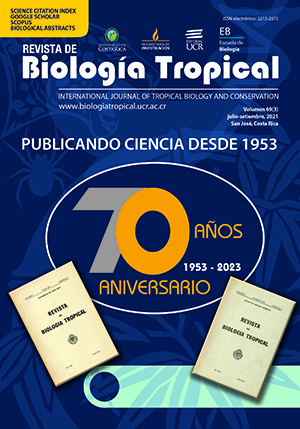Abstract
Introduction: Development of trout aquacultural activity has gradually increased in Costa Rican highlands. Residual waters from this activity are discarded directly on the rivers without any previous treatment process. Consequently, this activity could severely contaminate the river with bacteria that can affect the human health. Objective: The objective of this study is to evaluate the bacteria contamination caused by the residual water from the trout aquacultural activity discarded directly on the upper drainage basin of the Río Savegre. Methods: We counted the number of total coliforms and Escherichia coli from samples obtained monthly (2015-2018) at 3 sections of the largest aquacultural development in the upper drainage of the river. We collected samples at the entrance of the fish ponds, at the exit, and 200 m downwards. We compared the bacteria counts among locations and sampling years. Results: We found fewer total coliforms and E. coli in the water collected just at the exit of the fish ponds. We counted more total coliforms in 2016 and 2017, and more E. coli in 2016. Conclusions: The number of total coliforms and E. coli is very high in the river, but unexpectedly their number decreased in the water discarded from the fish tanks. The contamination of the river is likely caused by the water produced by other human activities and other aquaculture developments that discard the residual water directly on the river. We speculate the mucus produced by the trouts or substances released by the moss that cover the wall of fish tanks could regulate the growth of bacteria populations as has been suggested in other studies.
Objective: The objective of this study is to evaluate the bacteria contamination caused by the residual water from the trout aquacultural activity discarded directly on the upper drainage basin of the Río Savegre.
Methods: We counted the number of total coliforms and Escherichia coli from samples obtained monthly (2015-2018) at 3 sections of the largest aquacultural development in the upper drainage of the river. We collected samples at the entrance of the fish ponds, at the exit, and 200 m downwards. We compared the bacteria counts among locations and sampling years.
Results: We found fewer total coliforms and E. coli in the water collected just at the exit of the fish ponds. We counted more total coliforms in 2016 and 2017, and more E. coli in 2016.
Conclusions: The number of total coliforms and E. coli is very high in the river, but unexpectedly their number decreased in the water discarded from the fish tanks. The contamination of the river is likely caused by the water produced by other human activities and other aquaculture developments that discard the residual water directly on the river. We speculate the mucus produced by the trouts or substances released by the moss that cover the wall of fish tanks could regulate the growth of bacteria populations as has been suggested in other studies.
References
Baird, R., Eaton, A., & Rice, E. W. (2017). Standard Methods for the Examination of Water and Wastewater (23rd Ed.). American Water Works Association & Water Environment Federation.
Bedwell, M. S., & Goulder, R. (1996). Bacterial outputs from ponds and tanks used in intensive fish farming bacterial outputs from ponds and tanks used in intensive fish farming. Letters in Applied Microbiology, 23, 412–416.
Brooks, F., Carrol, K., Butel, J. Morse, S., & Mietzner, T. (2011). Microbiología Médica. McGraw-Hill Interamericana.
Dash, S., Das, S. K., Samal, J., & Thatoi, H. N. (2018). Epidermal mucus, a major determinant in fish health: a review. Iranian Journal of Veterinary Research, 19, 72–81.
Jang, J., Hur, H. G., Sadowsky, M. J., Byappanahalli, M. N., Yan, T., & Ishii, S. (2017). Environmental Escherichia coli: ecology and public health implications—a review. Journal of Applied Microbiology, 123, 570–581.
Khazigaleeva, R. A., Vinogradova, S. V., Petrova, V. L., Fesenko, I. A., Arapidi, G. P., Kamionskaya, A. M., Govorun, V. M., & Ivanov, V. T. (2017). Antimicrobial activity of endogenous peptides of the moss Physcomitrella patens. Russian Journal of Bioorganic Chemistry, 43, 248–254.
Kuznetsova, A., Brockhoff, P. B., & Christensen, R. H. B. (2017). lmerTest Package: tests in linear mixed effects models. Journal of Statistical Software, 82, 1–26.
Lenth, R. V., Buerkner, P., Herve, M., Love, J., Miguez, F., Riebl, H., & Singmann, H. (2022). Emmeans: Estimated marginal means, aka least-squares means. https://cran.r-project.org/web/packages/emmeans/index.html
Morales, G., Blanco, L., Arias, M. L., & Chaves, C. (2004). Evaluación de la calidad bacteriológica de tilapia fresca (Oreochromis niloticus) proveniente de la Zona Norte de Costa Rica. Archivos Latinoamericanos de Nutrición, 54, 433–437.
Otárola, A. (2018). Departamento de Acuicultura, INCOPESCA.
R Core Team. (2020). R: A language and environment for statistical computing. R Foundation for statistical computing, Vienna, Austria. https://www.R-project.org
Salfinger, Y., & Tortorello M. L. (2015). Compendium of methods for the microbiological examination of foods (5th Ed.). American Public Health Association.
Sánchez, J. E., Barrantes, G., & Durán, F. (2004). Distribución, ecología y conservación de las aves de la cuenca del río Savegre, Costa Rica. Brenesia, 61, 63–93.
Savaroğlu, F., Filik-Işcen, C. Oztopcu-Vatan, A. P., Kabadere, S., Ilhan, S., & Uyar, R. (2011). Determination of antimicrobial and antiproliferative activities of the aquatic moss Fontinalis antipyretica Hedw. Turkish Journal of Biology, 35, 361–369.
Sidoruk, M. (2019). Effect of rainbow trout production in a two-stage cascade system on water quality. Journal of Elementology, 24, 739–753.
Subramanian, S., MacKinnon, S. L., & Ross, N. W. (2007). A comparative study on innate immune parameters in the epidermal mucus of various fish species. Comparative Biochemistry and Physiology, 148, 256–263.
Subramanian, S., Ross, N. W., & MacKinnon, S. L. (2008). Comparison of antimicrobial activity in the epidermal mucus extracts of fish. Comparative Biochemistry and Physiology, 150, 85–92.
Waylen, P. R., Quesada, M. E, & Caviedes, C. N. (1994). The effects of El Niño-southern oscillation on precipitation in San José, Costa Rica. International Journal of Climatology, 14, 559–568.
##plugins.facebook.comentarios##

This work is licensed under a Creative Commons Attribution 4.0 International License.
Copyright (c) 2023 Revista de Biología Tropical







